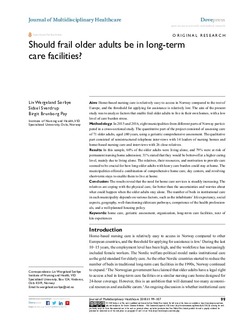| dc.description.abstract | Home-based nursing care is relatively easy to access in Norway compared to the rest of Europe, and the threshold for applying for assistance is relatively low. The aim of the present study was to analyze factors that enable frail older adults to live in their own homes, with a low level of care burden stress. In 2015 and 2016, eight municipalities from different parts of Norway participated in a cross-sectional study. The quantitative part of the project consisted of assessing care of 71 older adults, aged ≥80 years, using a geriatric comprehensive assessment. The qualitative part consisted of semistructured telephone interviews with 14 leaders of nursing homes and home-based nursing care and interviews with 26 close relatives. In this sample, 60% of the older adults were living alone, and 79% were at risk of permanent nursing home admission; 31% stated that they would be better-off at a higher caring level, mainly due to living alone. The relatives, their resources, and motivation to provide care seemed to be crucial for how long older adults with heavy care burden could stay at home. The municipalities offered a combination of comprehensive home care, day centers, and revolving short-term stays to enable them to live at home. Conclusion: The results reveal that the need for home care services is steadily increasing. The relatives are coping with the physical care, far better than the uncertainties and worries about what could happen when the older adults stay alone. The number of beds in institutional care in each municipality depends on various factors, such as the inhabitants’ life expectancy, social aspects, geography, well-functioning eldercare pathways, competence of the health professionals, and a well-planned housing policy. | nb_NO |
